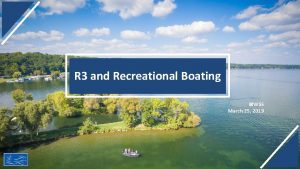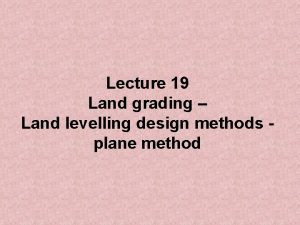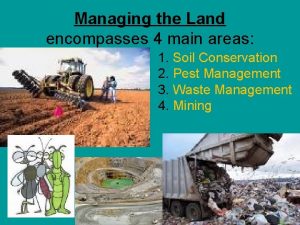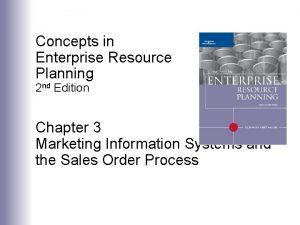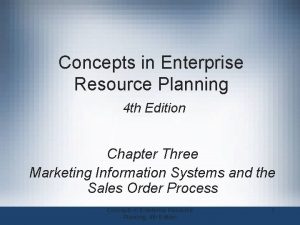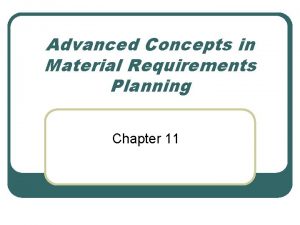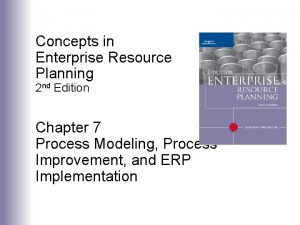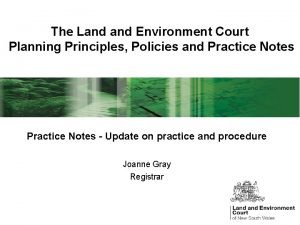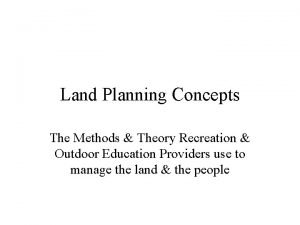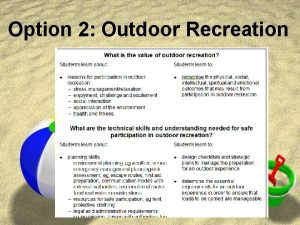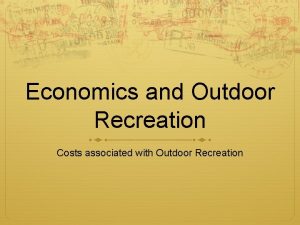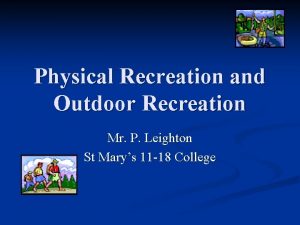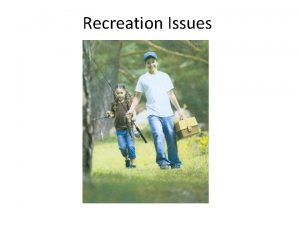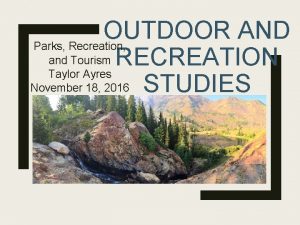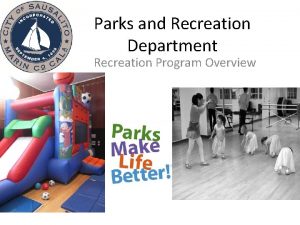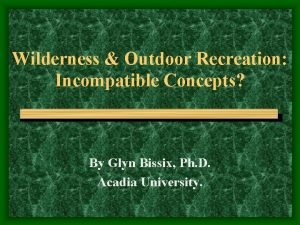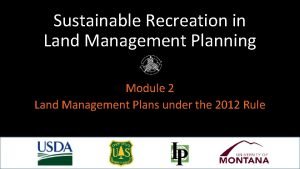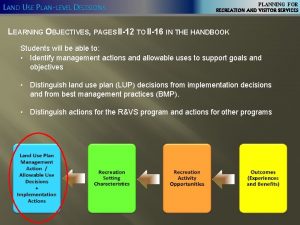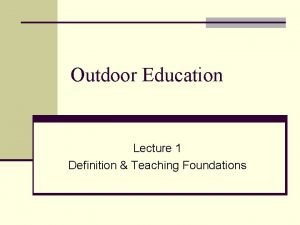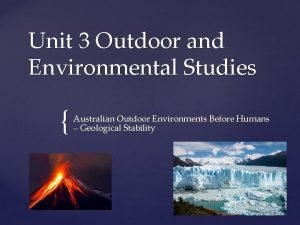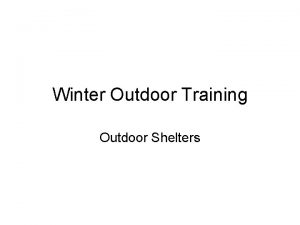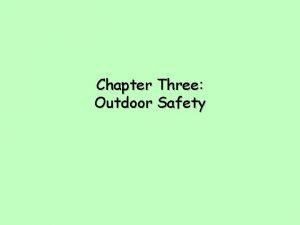Land Planning Concepts The Methods Theory Recreation Outdoor












































- Slides: 44

Land Planning Concepts The Methods & Theory Recreation & Outdoor Education Providers use to manage the land & the people

Sustainability “The health of the oceans depends on the health of the rivers; the health of the rivers depends on the health of small streams; the health of small streams depends on the health of their watersheds” Wendell Berry, from a book of essays titled “The Way of Ignorance” – in Duluth News Tribune 11/2/08

What is Sustainability? • Brundtlund Commission Report, Our Common Future (1987) o “Sustainable Development is development that meets the needs of the present without compromising the ability of future generations to meet their own needs. ” • Sustainability Education: Putting the concept into practice for citizens. Sustainability as three concentric circles (Hart, 2000).

Three Pillars of Sustainability (Brundtland Report, 1987)


Menominee Nation Model of Sustainability http: //sustainabledevelopmentinstitute. org/wp-content/uploads/2014/03/SDIMenominee. Model. jpg • An indigenous theoretical model of sustainability • Based on 6 pillars: – Land Sovereignty – Natural Environment – Institutions – Technology – Economics – Human Perception, Activity, & Behavior

Sustainability Education: Primary Methodological Principles • Experiential learning through investigating a perceived sustainability issue • Cooperative learning (Johnson & Johnson, 2002) • Project-Based Learning • Community-Based learning • Student-centered learning • Presentation (teaching) to a professional adult audience UNESCO. (2011). Education for Sustainable Development: An Expert Review of Processes and Learning. http: //unesdoc. unesco. org/images/001914/191442 e. pdf

Basic Planning Approaches • Limits of Acceptable Change (LAC) • Best Management Practices (MPCA, ca 1975) – vs. Best Practices • Public Participation • Multiple Use • Recreation Opportunity Spectrum (ROS)

Limits of Acceptable Change (G. H. Stankey, D. N. Cole, R. C. Lucas, M. E. Petersen. & S. S. Frissell, 1985) • Based upon a set of baseline data To know the area before development • An effort to prevent desensitization • Reflects biological, physical, and social conditions The social demands are what most influence the biological & physical

• The Limits of Acceptable Change (LAC) planning system • Response to growing recognition in the U. S. that attempts to define and implement recreational carrying capacities were both excessively reductionistic and failing. • Carrying capacity concept itself was based on biological models. • Such models did not transfer well into ecosystems being managed for human benefits based primarily on recreational experiences

• LAC was based on the recognition that • ( 1) specific objectives were needed to identify what it was that management was to protect, • (2) change is always present in nature-dominated systems, • (3) any recreational use leads to some change, • (4) management is therefore confronted with the question of how much change is acceptable, and • (5) monitoring of the outcomes of management is needed to determine if actions were effective. (Mc. Cool, 1989. Paper presented at Workshop on Impact Management in Marine Parks, sponsored by Maritime Institute of Malaysia, August 13 -14, 1996, Kuala Lumpur, MALA YSIA)

Ecosystem Services

Preliminary Kingsbury Bay-Grassy Point HIA Pathways 8/14/17 Ecosystem Services: Water Habitat and Quality ∆ Social Capital (see Social and Cultural) Habitat Restoration Construction/Operations ∆ Water Habitat/ Vegetation (including invasive species) ∆ Construction Equipment Operation 1 ∆ Sediment Disturbance - Kingsbury Bay - Sediment Cap at IDX - Grassy Point ∆ Aesthetics/Recreation (see Recreation, Aesthetics, and Engagement with Nature) ∆ Chronic Disease ∆ Fauna Composition ∆ Waterborne Construction Equipment Leaks ∆ Water, Sediment, and Biota Pollutant Levels ∆ Nutrition Impacts to Fish Consumption ∆ Waterborne Illness Park Improvements Construction Park Improvements Operations and Maintenance 1 From ∆ Erosion/Runoff ∆ Stormwater Retention ∆Water, Sediment, and Biota Pollutant Exposure* Actual and Perceived ∆ Fish Consumption/Water Contact Advisories ∆ Stress ∆ Skin/Eye Ailments Equipment, Traffic, and Transport Pathway * Water Pollutant Exposure includes construction crews, recreational users, and individuals fishing for consumption • Health impacts of stress include: poor mental health, high blood pressure, heart disease, obesity, diabetes, decreased immune response • Health impacts of chronic disease includes: cardiovascular disease, hypertension, stroke, kidney failure

Health Impact Assessment (U. S. EPA) • Similar to Public Participation • The EPA is evaluating Health Impact Assessment (HIA) as a decision-support tool for promoting sustainable and healthy communities. The foundation of a healthy community is strongest when built upon a decision-making process that balances environmental, social, and economic factors to promote the health and well-being of its members (https: //www. epa. gov/healthresearch/health-impact-assessments, 2018).

Steps of HIA Screening, to determine whether a proposal is likely to have health effects and whether the HIA will provide useful information Scoping, to establish the scope of health effects that will be included in the HIA, the populations affected, the sources of data and the methods to be used Assessment, which is a two step process that first describes the baseline health status and then assesses potential impacts Slide content courtesy of J. Dills, Georgia Health Policy Center 15

Steps of HIA Recommendations suggest design alternatives that could be implemented to improve health or action that could be taken to manage health effects Reporting presents findings and recommendations to decision-makers and stakeholders Monitoring and evaluation includes monitoring the implementation of HIA recommendations. Evaluation can be of process, impact or outcomes Slide content courtesy of J. Dills, Georgia Health Policy Center 16

Where are we in the HIA process? Screening Scoping Assessment Recommendations Reporting Monitoring and Evaluation February 2017 – Community/Stakeholder Meetings Spring 2017 – Community/Stakeholder Consultation September/October 2017 – Community/Stakeholder Meetings Fall 2017 (March 2018) – Draft HIA Complete December 2017 – Final HIA 17 Complete

Multiple Use (Multiple Use Sustained Yield Act, 1960) • Coined by Gifford Pinchot (1905) • An effort to provide multiple compatible uses for an area • It is not everyone’s right to use the same area.

Designations (Classes) in ROS • • • Primitive Semi-primitive Nonmotorized Semi-primitive Motorized Roaded Natural Rural Urban

























 Trends in outdoor recreation
Trends in outdoor recreation Outdoor recreation adoption model
Outdoor recreation adoption model Outdoor recreation resources review commission
Outdoor recreation resources review commission What are landforms
What are landforms A pointed piece of land extending into the sea
A pointed piece of land extending into the sea Criteria for land levelling
Criteria for land levelling Land reclamation methods
Land reclamation methods Indirect methods of contoring uses how many methods
Indirect methods of contoring uses how many methods Enterprise resourse planning
Enterprise resourse planning Concepts in enterprise resource planning
Concepts in enterprise resource planning Material requirements planning concepts
Material requirements planning concepts Fitter snacker
Fitter snacker Land use planning lecture notes
Land use planning lecture notes Land economics lecture notes
Land economics lecture notes Land use planning lecture notes
Land use planning lecture notes Define land use planning
Define land use planning Land and environment court planning principles
Land and environment court planning principles Hình ảnh bộ gõ cơ thể búng tay
Hình ảnh bộ gõ cơ thể búng tay Slidetodoc
Slidetodoc Bổ thể
Bổ thể Tỉ lệ cơ thể trẻ em
Tỉ lệ cơ thể trẻ em Voi kéo gỗ như thế nào
Voi kéo gỗ như thế nào Chụp tư thế worms-breton
Chụp tư thế worms-breton Chúa sống lại
Chúa sống lại Các môn thể thao bắt đầu bằng tiếng đua
Các môn thể thao bắt đầu bằng tiếng đua Thế nào là hệ số cao nhất
Thế nào là hệ số cao nhất Các châu lục và đại dương trên thế giới
Các châu lục và đại dương trên thế giới Cong thức tính động năng
Cong thức tính động năng Trời xanh đây là của chúng ta thể thơ
Trời xanh đây là của chúng ta thể thơ Mật thư anh em như thể tay chân
Mật thư anh em như thể tay chân 101012 bằng
101012 bằng độ dài liên kết
độ dài liên kết Các châu lục và đại dương trên thế giới
Các châu lục và đại dương trên thế giới Thể thơ truyền thống
Thể thơ truyền thống Quá trình desamine hóa có thể tạo ra
Quá trình desamine hóa có thể tạo ra Một số thể thơ truyền thống
Một số thể thơ truyền thống Cái miệng nó xinh thế chỉ nói điều hay thôi
Cái miệng nó xinh thế chỉ nói điều hay thôi Vẽ hình chiếu vuông góc của vật thể sau
Vẽ hình chiếu vuông góc của vật thể sau Thế nào là sự mỏi cơ
Thế nào là sự mỏi cơ đặc điểm cơ thể của người tối cổ
đặc điểm cơ thể của người tối cổ Giọng cùng tên là
Giọng cùng tên là Vẽ hình chiếu đứng bằng cạnh của vật thể
Vẽ hình chiếu đứng bằng cạnh của vật thể Fecboak
Fecboak Thẻ vin
Thẻ vin đại từ thay thế
đại từ thay thế

